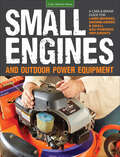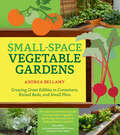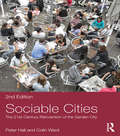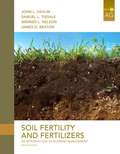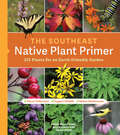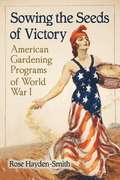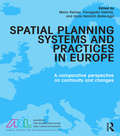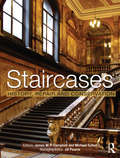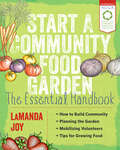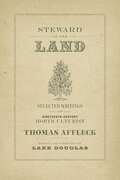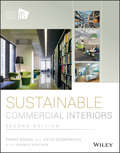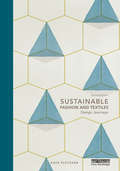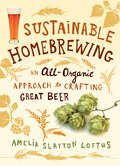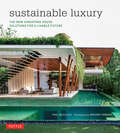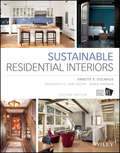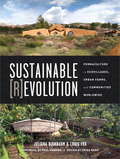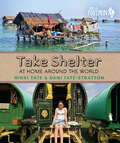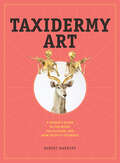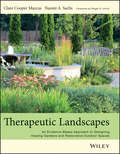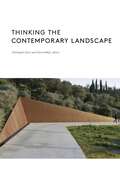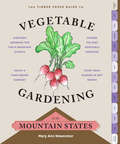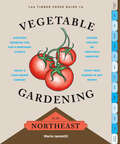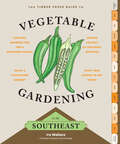- Table View
- List View
Small Engines and Outdoor Power Equipment: A Care & Repair Guide for: Lawn Mowers, Snowblowers & Small Gas-Powered Implements
by Peter HunnThis new book is more than a simple engine repair manual. Designed for the beginner with little or no mechanical experience, Small Engines & Outdoor Power Equipment is a graphically appealing, step-by-step guide that covers all of the most important engine maintenance and repair skills you'll need to keep your equipment running at peak performance. It also shows exactly how to perform mechanical upkeep and repairs on the most common outdoor power implements, including lawn mowers, snow blowers, chain saws, power washers, generators, leaf blowers, rototillers, wood splitters, lawn edgers, and weed whips. With clear 'how-to' photos and detailed diagrams, you'll see exactly what needs to be done. A comprehensive troubleshooting guide helps you define problems and enact solutions. With Small Engines & Outdoor Power Equipment in your library, you won't need to haul the lawn mower off to the repair center and wait a few weeks just because a filter is plugged or the old gas needs to be replaced. Among the many skills you'll learn are seasonal tune-ups, changing oil, servicing spark plugs, cleaning filters, replacing muffler, servicing the fuel tank, overhauling the carburetor, servicing brakes, inspecting flywheels, replacing the fuel pump, and replacing a rewind cord.
Small-Space Vegetable Gardens: Growing Great Edibles in Containers, Raised Beds, and Small Plots
by Andrea Bellamy“If I could recommend one book for small-space vegetable gardening, this would be it. Andrea Bellamy nailed it!” —Joe Lamp’l, Growing a Greener WorldSmall-Space Vegetable Gardens explains the basics of growing a bounty of edibles in a minimal amount of space. Andrea Bellamy, author of the award-winning blog Heavy Petal, shares all the knowledge she’s gained from years of gardening small: how to find and assess a space, and how to plan and build a garden. Bellamy also highlights the top sixty edible plants and offers complete information on how to sow, grow, and harvest them. This hardworking and enthusiastic guide teaches gardeners how to take advantage of the space they have—whether it’s a balcony, a patio, a plot in a community garden, or even a small yard—to create the food garden of their dreams.
Sociable Cities: The 21st-Century Reinvention of the Garden City (Planning, History and Environment Series)
by Peter Hall Colin WardPeter Hall and Colin Ward wrote Sociable Cities to celebrate the centenary of publication of Ebenezer Howard’s To-morrow: A Peaceful Path to Real Reform in 1998 – an event they then marked by co-editing (with Dennis Hardy) the magnificent annotated facsimile edition of Howard’s original, long lost and very scarce, in 2003. In this revised edition of Sociable Cities, sadly now without Colin Ward, Peter Hall writes: ‘the sixteen years separating the two editions of this book seem almost like geological time. Revisiting the 1998 edition is like going back deep into ancient history’. The glad confident morning following Tony Blair’s election has been followed by political disillusionment, the fiscal crash, widespread austerity and a marked anti-planning stance on the part of the Coalition government. But – closely following the argument of Good Cities, Better Lives: How Europe discovered the Lost Art of Urbanism (Routledge 2013), to which this book is designed as a companion – Hall argues that the central message is now even stronger: we need more planning, not less. And this planning needs to be driven by broad, high-level strategic visions – national, regional – of the kind of country we want to see. Above all, Hall shows in the concluding chapters, Britain’s escalating housing crisis can be resolved only by a massive programme of planned decentralization from London, at least equal in scale to the great Abercrombie plan seventy years ago. He sets out a picture of great new city clusters at the periphery of South East England, sustainably self-sufficient in their daily patterns of living and working, but linked to the capital by new high-speed rail services. This is a book that every planner, and every serious student of policy-making, will want to read. Published at a time when the political parties are preparing their policy manifestos, it is designed to make a major contribution to a major national debate.
Soil Fertility and Fertilizers: An Introduction to Nutrient Management, Eighth Edition
by John L. Havlin Samuel L. Tisdale Werner L. Nelson James D. BeatonSoil Fertility and Fertilizers: An Introduction to Nutrient Management, Eighth Edition, provides a thorough understanding of the biological, chemical, and physical properties affecting soil fertility and plant nutrition. Covering all aspects of nutrient management for profitable crop production, the text pays particular attention to minimizing the environmental impact of soil and fertilizer management. The eighth edition of this proven text has been substantially revised to reflect rapidly advancing knowledge and technologies in both plant nutrition and nutrient management.
The Southeast Native Plant Primer: 225 Plants for an Earth-Friendly Garden
by Larry Mellichamp Paula GrossBring Your Garden to Life—and Life to Your Garden Do you want a garden that makes a real difference? Choose plants native to our Southeast region. The rewards will benefit you, your yard, and the environment—from reducing maintenance tasks to attracting earth-friendly pollinators such as native birds, butterflies, and bees. Native plant experts Larry Mellichamp and Paula Gross make adding these superstar plants easier than ever before, with proven advice that every home gardener can follow. This incomparable sourcebook includes 225 recommended native ferns, grasses, wildflowers, perennials, vines, shrubs, and trees. It&’s everything you need to know to create a beautiful and beneficial garden. This must-have handbook is for gardeners in Alabama, Florida, Georgia, Mississippi, North Carolina, South Carolina, Tennessee, and Virginia.
Sowing the Seeds of Victory: American Gardening Programs of World War I
by Rose Hayden-SmithSometimes, to move forward, we must look back. Gardening activity during American involvement in World War I (1917-1919) is vital to understanding current work in agriculture and food systems. The origins of the American Victory Gardens of World War II lie in the Liberty Garden program during World War I. This book examines the National War Garden Commission, the United States School Garden Army, and the Woman's Land Army (which some women used to press for suffrage). <P><P> The urgency of wartime mobilization enabled proponents to promote food production as a vital national security issue. The connection between the nation's food readiness and national security resonated within the U.S., struggling to unite urban and rural interests, grappling with the challenges presented by millions of immigrants, and considering the country's global role. The same message--that food production is vital to national security--can resonate today. These World War I programs resulted in a national gardening ethos that transformed the American food system.
Spatial Planning Systems and Practices in Europe: A Comparative Perspective on Continuity and Changes
by Mario Reimer Panagiotis Getimis Hans Heinrich BlotevogelIdeal for students and practitioners working in spatial planning, the Europeanization of planning agendas and regional policy in general Spatial Planning Systems and Practices in Europe develops a systematic methodological framework to analyze changes in planning systems throughout Europe. The main aim of the book is to delineate the coexistence of continuity and change and of convergence and divergence with regard to planning practices across Europe. Based on the work of experts on spatial planning from twelve European countries the authors underline the specific and context-dependent variety and disparateness of planning transformation, focusing on the main objectives of the changes, the driving forces behind them and the main phases and turning points, the main agenda setting actors, and the different planning modes and tools reflected in the different "policy and planning styles". Along with a methodological framework the book includes twelve country case studies and the comparative conclusions covering a variety of planning systems of EU member states. According to the four "ideal types" of planning systems identified in the EU Compendium, at least two countries have been selected from each of the four different planning traditions: regional-economic (France, Germany), Urbanism (Greece, Italy), comprehensive/integrated (Denmark ,Finland, Netherlands, Germany), "land use planning" (UK, Czech Republic, Belgium/Flanders), along with two additional case studies focusing on the recent developments in eastern European countries by looking at Poland and in southern Europe looking at Turkey.
Staircases: History, Repair and Conservation
by James W.P. Campbell Michael Tutton Jill PearceThe staircase dates back to the very beginning of architectural history. Virtually every significant building from the ziggurats of ancient Mesopotamia to the present day, has not only contained one or more staircases, but has celebrated them. For such an apparently simple part of a building they have been made in a bewildering variety of forms and from a wide range of materials. Every age has sought to out-perform the previous to produce ever more spectacular and gravity-defying designs. 'Staircases: History, Repair and Conservation' is the first major reference volume devoted entirely to the understanding of staircases and the issues surrounding their repair and conservation. Each chapter has been especially written by experts in their respective fields. The book is essential reading for professionals and anyone with an interest in staircases. It deals with the history; dating; archaeology; surveying and recording; engineering; curating; repair and conservation of the staircase in a single volume. No other book offers such a wide range of detail. The book is divided into three parts: Part 1 covers the history, development, identification and dating of staircases, providing detailed drawings and photographs and an introduction to the scientific techniques available to enable the accurate dating of staircases. Part 2 covers the design, engineering and maintenance of the staircase, giving a clear guide to the latest research into the design of safe staircases and their structural stability. Part 3 focuses on the materials commonly used to make stairs, detailing the appropriate techniques for their conservation and repair. The result is a comprehensive study encompassing considerable and far reaching research which aims to inform our understanding and advance the scholarship of the subject for years to come.
Start a Community Food Garden: The Essential Handbook
by LaManda JoyRecommended by the American Community Gardening Association Community gardening enhances the fabric of towns and cities through social interactions and accessibility to fresh food, creating an enormously positive effect in the lives of everyone it touches. LaManda Joy, the founder of Chicago’s Peterson Garden Project and a board member of the American Community Gardening Association, has worked in the community gardening trenches for years and brings her knowledge to the wider world in Start a Community Food Garden. This hardworking guide covers every step of the process: fundraising, community organizing, site sourcing, garden design and planning, finding and managing volunteers, and managing the garden through all four seasons. A section dedicated to the basics of growing was designed to be used by community garden leaders as an educational tool for teaching new members how to successfully garden.
Steward of the Land: Selected Writings of Nineteenth-Century Horticulturist Thomas Affleck (The Hill Collection: Holdings of the LSU Libraries)
by Lake Douglas Thomas AffleckIn the first collection of published writings of Thomas Affleck (1812--1868), Lake Douglas re-establishes the reputation of a tireless agricultural reformer, entrepreneur, and horticulturist. Affleck's wide range of interests -- animal husbandry, agriculture, scientific farming, ornamental horticulture, insects, and hydrology, among others -- should afford him a celebrated status in several disciplines; yet until now his immense contributions remained largely unheralded. Steward of the Land remedies this oversight with a broad, annotated selection of Affleck's works, rightfully placing him alongside his better-known contemporaries Andrew Jackson Downing and Frederick Law Olmsted.After immigrating to the United States from Scotland in 1832, Affleck witnessed the burgeoning American expansion and its major advances in agriculture and technology. He worked as a journalist for the influential Western Farmer and Gardener, covering Ohio, Kentucky, and the Mississippi River Valley. Affleck moved to Mississippi in 1842 to manage his new wife's failing plantation; there, he created one of the first commercial nurseries of the South while writing prolifically on numerous agrarian topics for regional periodicals and newspapers. From 1845 to 1865 he edited Affleck's Southern Rural Almanac and Plantation and Garden Calendar, published in New Orleans. Following a postwar move to Brenham, Texas, he published letters and essays about rebuilding that state's livestock herds and rejuvenating its agricultural labor forces.Steward of the Land includes excerpts from dozens of Affleck's articles on subjects ranging from bee keeping to gardening to orchard tending. This valuable single-volume resource reveals Affleck's astonishing breadth of horticultural knowledge and entrepreneurial sagacity, and his role in educating mid-nineteenth-century readers about agricultural products and practices, plant usage, and environmental stewardship. Never before collected or contextualized, Affleck's writings provide a firsthand account of the advancement of agricultural techniques and practices that created a new environmental awareness in America.
Sustainable Commercial Interiors
by Penny Bonda Katie SosnowchikDiscover new approaches to green design and sustainable building with this comprehensive guide There's a substantial amount of information designers and architects need to understand about sustainability and commercial projects, especially as expectations for professionals in the industry become clearer. Luckily, the second edition of Sustainable Commercial Interiors has been revamped to serve as a comprehensive guide for anyone looking to understand the latest in green and sustainable design. Fully revised throughout, this resource now includes frameworks based on the new LEED v4 rating system, and provides fifteen brand-new case studies that document green design and building strategies for all types of projects. You'll find information on materials, furnishings, finishes, product standards, and certifications, all designed to keep you in the know and prepare you for future ventures in sustainable design. The ideal professional companion for interior designers, commercial builders and developers, architects, and interior design students, this guide is an all-in-one introduction to the most essential topics in the industry, such as global environmental issues, water and energy usage, and the tools of the trade, to name just a few. The book is illustrated with full color images throughout. Fully revised and updated to include information on the new LEED v4 rating system Discusses the past, present, and future of sustainable design Considers global environmental issues, such as waste, land use, and bio-inspired design Covers water and energy usage and sustainable materials Discover the benefits of green building and adopt new approaches to sustainable design. Sustainable Commercial Interiors is your go-to resource for navigating new expectations for responsible interior design.
Sustainable Fashion and Textiles: Design Journeys
by Kate FletcherFully revised and updated, the second edition of Sustainable Fashion and Textiles: Design Journeys continues to define the field of design in fashion and textiles. Arranged in two sections, the first four chapters represent key stages of the lifecycle: material cultivation/extraction, production, use and disposal. The remaining four chapters explore design approaches for altering the scale and nature of consumption, including service design, localism, speed and user involvement. While each chapter is complete in and of itself, their real value comes from what they represent together: innovative ways of thinking about textiles and garments based on sustainability values and an interconnected approach to design. Including a new preface, updated content and a new conclusion reflecting and critiquing developments in the field, as well as discussing future developments, the second edition promises to provide further impetus for future change, sealing Sustainable Fashion and Textiles: Design Journeys as the must-buy book for fashion and textiles professionals and students interested in sustainability.
Sustainable Homebrewing: An All-Organic Approach to Crafting Great Beer
by Amelia Slayton LoftusBrew delicious organic beer at home. In this comprehensive guide, Amelia Slayton Loftus covers everything you need to know to brew at home with organic ingredients, stressing practices that minimize waste and use sustainable resources. Along with 30 irresistible recipes, Loftus provides expert tips on buying equipment, harnessing solar energy, recycling water, using spent grain, and growing your own organic barley, hops, and herbs. You’ll enjoy brewing homemade beer that not only tastes great, but is good for the environment.
Sustainable Luxury
by Paul Mcgillick Masano KawanaSingapore is celebrated as one of the most livable cities in Asia, and Sustainable Luxury shows how the prosperous, forward-looking nation is pioneering innovative solutions for environmental, economic, social, and cultural issues faced the world over. Dr. Paul McGillick, the author of The Sustainable Asian House (Tuttle, 2013), presents twenty-seven recent residential projects created by Singapore's most talented architects to address the many complex and interconnected aspects of sustainability.Some of the homes featured here emphasize environmental needs, while others are concerned with preserving cultural traditions or supporting societal and interpersonal needs-such as extended family dwellings. Each residence, however, exhibits solutions developed from a holistic point of view. These homes typically embrace the tropical climate rather than fight it, and illustrate how smart manipulation of air flows, light, shade, water, and landscaping sustain higher levels of comfort without resorting to air-conditioning.In addition to profiling individual residences, Sustainable Luxury looks at the big picture, canvassing the most pressing issues-including changing demographics and lifestyles-and examining the available solutions. Anyone concerned with the future of our world will be fascinated by the houses presented here and the ways in which Singapore is leading the way in the development of residential architecture that is as luxurious as it is sustainable.
Sustainable Luxury
by Paul McgillickSingapore is celebrated as one of the most livable cities in Asia, and Sustainable Luxury shows how the prosperous, forward-looking nation is pioneering innovative solutions for environmental, economic, social, and cultural issues faced the world over. Dr. Paul McGillick, the author of The Sustainable Asian House (Tuttle, 2013), presents twenty-seven recent residential projects created by Singapore's most talented architects to address the many complex and interconnected aspects of sustainability. Some of the homes featured here emphasize environmental needs, while others are concerned with preserving cultural traditions or supporting societal and interpersonal needs-such as extended family dwellings. Each residence, however, exhibits solutions developed from a holistic point of view. These homes typically embrace the tropical climate rather than fight it, and illustrate how smart manipulation of air flows, light, shade, water, and landscaping sustain higher levels of comfort without resorting to air-conditioning. In addition to profiling individual residences, Sustainable Luxury looks at the big picture, canvassing the most pressing issues-including changing demographics and lifestyles-and examining the available solutions. Anyone concerned with the future of our world will be fascinated by the houses presented here and the ways in which Singapore is leading the way in the development of residential architecture that is as luxurious as it is sustainable.
Sustainable Luxury
by Paul McgillickSingapore is celebrated as one of the most livable cities in Asia, and Sustainable Luxury shows how the prosperous, forward-looking nation is pioneering innovative solutions for environmental, economic, social, and cultural issues faced the world over. Dr. Paul McGillick, the author of The Sustainable Asian House (Tuttle, 2013), presents twenty-seven recent residential projects created by Singapore's most talented architects to address the many complex and interconnected aspects of sustainability. Some of the homes featured here emphasize environmental needs, while others are concerned with preserving cultural traditions or supporting societal and interpersonal needs-such as extended family dwellings. Each residence, however, exhibits solutions developed from a holistic point of view. These homes typically embrace the tropical climate rather than fight it, and illustrate how smart manipulation of air flows, light, shade, water, and landscaping sustain higher levels of comfort without resorting to air-conditioning. In addition to profiling individual residences, Sustainable Luxury looks at the big picture, canvassing the most pressing issues-including changing demographics and lifestyles-and examining the available solutions. Anyone concerned with the future of our world will be fascinated by the houses presented here and the ways in which Singapore is leading the way in the development of residential architecture that is as luxurious as it is sustainable.
Sustainable Residential Interiors
by Annette Stelmack Associates III Kari Foster Debbie HindmanThe Second Edition of Sustainable Residential Interiors addresses cutting edge processes, strategies, and principles as well as details for in-depth product vetting criteria. Award-winning, leading interior designer Annette Stelmack shares her expertise from the perspective of LEED Building Design & Construction projects, healthy interiors, and chemical sensitivities, addressing principles, strategies, and solutions for design practitioners. A comprehensive update of the current state of the sustainable interior design industry is provided, including present and upcoming industry transformations, thought-leading principles, strategies and practices for project implementation, and fine points and resources for in-depth product vetting to support high-performing, healthy interiors. Sustainable Residential Interiors takes readers through an integrated design process, demonstrating relevant principles and practices that apply to essentially any interiors project toward creating an environment that is healthy, high-performing, functional, sustainable, and beautiful. In doing so, it: Promotes critical thinking about health and environmental issues in the building industry Features checklists and current resources, providing a "hands on" practical approach Addresses in-depth, applicable third party certifications and details on relevant building rating systems Provides in-depth strategies and criteria for fixed interior finishes, fixtures, equipment and furnishings Demonstrates successful, relevant, diverse and inspiring case studies Delivers comprehensive tools and resources for researching and vetting products' composition and chemical make-up. Evaluates all aspects of a building's interior to identify and implement methods that: save energy and water; reduce Co2 emissions and waste; improve indoor air quality free of toxins; and are responsive to environmental impacts Encourages forward-thinking by featuring inspirational statements from mentors, peers, and industry leaders Urges interior designers to commit to designing safe, healthy environments that are integral to a professional code of ethics, which ensure the delivery of positive outcomes for the client and any building's future occupants
Sustainable Revolution
by Paul Hawken Louis Fox Juliana Birnbaum Erika RandUrban gardeners. Native seed-saving collectives. Ecovillage developments. What is the connection between these seemingly disparate groups? The ecological design system of permaculture is the common thread that weaves them into a powerful, potentially revolutionary--or reevolutionary--movement. Permaculture is a philosophy based on common ethics of sustainable cultures throughout history that have designed settlements according to nature's patterns and lived within its bounds. As a movement that has been building momentum for the past 40 years, it now is taking form as a growing network of sites developed with the intention of regenerating local ecologies and economies. Permaculture strategies can be used by individuals, groups, or nations to address basic human needs such as food, water, energy, and housing. As a species, humans are being called forth to evolve, using our collective intelligence to meet the challenges of the future. Yet if we are to survive our collective planetary crisis, we need to revisit history, integrating successful systems from sustainable cultures. To boldly confront our position on the brink of the earth's carrying capacity and make changes that incorporate the wisdom of the past is truly revolutionary. Sustainable Revolution features the work of a worldwide network of visionaries, including journalists, activists, indigenous leaders and permaculturists such as David Holmgren, Vandana Shiva, Charles Eisenstein, Starhawk, Erik Assadourian, Victoria Tauli-Corpuz, Albert Bates, and Geoff Lawton. This beautifully photographed collection of profiles, interviews, and essays features 60 innovative community-based projects in diverse climates across the planet. Edited by anthropologist Juliana Birnbaum Fox and award-winning activist filmmaker Louis Fox, it can be read as an informal ethnography of an international culture that is modeling solutions on the cutting edge of social and environmental change. The research presented in the book frames the permaculture movement as a significant ally to marginalized groups, such as the urban poor and native communities resisting the pressures of globalization. Sustainable Revolution uplifts and inspires with its amazing array of dynamic activists and thriving, vibrant communities.From the Trade Paperback edition.
Take Shelter: At Home Around the World (Orca Footprints #5)
by Nikki Tate Dani Tate-StrattonA roof, a door, some windows, a floor. All houses have them, but not all houses are alike. Some have wings (airplane homes), some have wheels (Romany vardoes), some float; some are made of straw, some of snow and ice. Some are enormous, some are tiny; some are permanent and some are temporary. But all are home. Take Shelter explores the way people live all over the world and beyond: from the Arctic to the Antarctic, from an underground house in Las Vegas to the International Space Station. Everywhere people live, they adapt to their surroundings and create unique environments, using innovative techniques to provide that most basic of needs: shelter.
Taxidermy Art: A Rogue's Guide to the Work, the Culture, and How to Do It Yourself
by Robert MarburyIn this collection of taxidermy art, you’ll find a winged monkey with a fez and a martini glass, a jewel-encrusted piglet, a bionic fawn, and a polar bear balancing on a floating refrigerator. Author Robert Marbury makes for a friendly (and often funny) guide, addressing the three big questions people have about taxidermy art: What is it all about? Can I see some examples? and How can I make my own? He takes readers through a brief history of taxidermy (and what sets artistic taxidermy apart) and presents stunning pieces from the most influential artists in the field. Rounding out the book are illustrated how-to lessons to get readers started on their own work, with sources for taxidermy materials and resources for the budding taxidermist.
Therapeutic Landscapes
by Clare Cooper Marcus Naomi A SachsThis comprehensive and authoritative guide offers an evidence-based overview of healing gardens and therapeutic landscapes from planning to post-occupancy evaluation. It provides general guidelines for designers and other stakeholders in a variety of projects, as well as patient-specific guidelines covering twelve categories ranging from burn patients, psychiatric patients, to hospice and Alzheimer's patients, among others. Sections on participatory design and funding offer valuable guidance to the entire team, not just designers, while a planting and maintenance chapter gives critical information to ensure that safety, longevity, and budgetary concerns are addressed.
Thinking the Contemporary Landscape
by Dora Imhof Christophe GirotOn the heels of our groundbreaking books in landscape architecture, James Corner's Recovering Landscape and Charles Waldheim's Landscape Urbanism Reader, comes another essential reader, . Examining our shifting perceptions of nature and place in the context of environmental challenges and how these affect urbanism and architecture, the seventeen essayists in argue for an all-encompassing view of landscape that integrates the scientific, intellectual, aesthetic, and mythic into a new multidisciplinary understanding of the contemporary landscape. A must-read for anyone concerned about the changing nature of our landscape in a time of climate crisis.
The Timber Press Guide to Vegetable Gardening in the Mountain States (Regional Vegetable Gardening Series)
by Mary Ann NewcomerGrowing vegetables requires regionally specific information—what to plant, when to plant it, and when to harvest are based on climate, weather, and first frost. The Timber Press Guide to Vegetable Gardening in the Mountain States tackles this need head on, with regionally specific growing information written by local gardening expert, Mary Ann Newcomer. This region includes Idaho, Montana, Wyoming, Utah, Colorado, eastern Washington and Oregon, northern Nevada, and the southernmost parts of Alberta and Saskatchewan. Monthly planting guides show exactly what you can do in the garden from January through December. The skill sets go beyond the basics with tutorials on seed saving, worm bins, and more.
The Timber Press Guide to Vegetable Gardening in the Northeast (Regional Vegetable Gardening Series)
by Marie IannottiGrowing vegetables requires regionally specific information—what to plant, when to plant it, and when to harvest are based on climate, weather, and first frost. The Timber Press Guide to Vegetable Gardening in the Northeast tackles this need head on, with regionally specific growing information written by local gardening expert, Marie Iannotti. This region includes Connecticut, Delaware, Maine, Massachusetts, New Hampshire, New Jersey, New York, Pennsylvania, Rhode Island, and Vermont. The southernmost parts of Ontario, New Brunswick, Novia Scotia, and Quebec are also included. Monthly planting guides show exactly what you can do in the garden from January through December. The skill sets go beyond the basics with tutorials on seed saving, worm bins, and more.
The Timber Press Guide to Vegetable Gardening in the Southeast (Regional Vegetable Gardening Series)
by Ira WallaceGrowing vegetables requires regionally specific information—what to plant, when to plant it, and when to harvest are based on climate, weather, and first frost. The Timber Press Guide to Vegetable Gardening in the Southeast tackles this need head on, with regionally specific growing information written by local gardening expert, Ira Wallace. This region includes Alabama, Arkansas, Florida, Georgia, Kentucky, Louisiana, Maryland, Mississippi, North Carolina, South Carolina, Tennessee, Virginia, and West Virginia. Monthly planting guides show exactly what you can do in the garden from January through December. The skill sets go beyond the basics with tutorials on seed saving, worm bins, and more.
